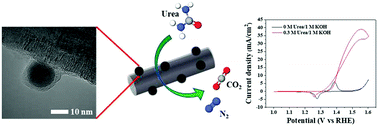An effective strategy for preparing nickel nanoparticles encapsulated in polymer matrix-derived carbon shell with high catalytic activity and long-term durability toward urea electro-oxidation†
Abstract
Direct urea fuel cells have been recognised as a potential approach for sustainable development. However, the low catalytic activity of urea oxidation has hindered its practical application. Herein, by employing a facile pyrolysis strategy, we successfully synthesised nano-sized nickel particles encapsulated in a carbon shell supported on carbon nanofibers. The morphology and structure of the synthesised catalysts were characterised by TGA, XRD, FE-SEM, HR-TEM, and XPS. The catalytic activity of the catalysts toward the electro-oxidation of urea was investigated using cyclic voltammetry. Ni@2CS/CNF was found to possess the smallest size and uniform particle distribution on the carbon support, thus manifesting exceptional performance and remarkable long-term durability. Therefore, this study demonstrated that the nickel-encapsulated by carbon shell can be applied for urea oxidation as an efficient catalyst in direct urea fuel cells.



 Please wait while we load your content...
Please wait while we load your content...